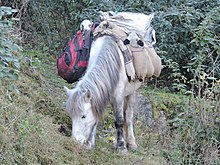
Summary
The Spiti Horse is a breed of small mountain horse or pony from Himachal Pradesh in northern India.[4] It takes its name from the Spiti River, and is found mainly in the Kullu,[5] Lahaul and Spiti and Kinnaur districts of the state.[6]
| Conservation status | |
|---|---|
| Other names |
|
| Country of origin | India |
| Distribution | Himachal Pradesh |
| Traits | |
| Weight | |
| Height | |


History edit
The origins of the Spiti Horse are unknown.[7] It takes its name from the Spiti River, and is found mainly in the Kullu,[5] Lahaul and Spiti and Kinnaur districts of the state.[6]
A breed population of 4000 was reported in 2004;[2] numbers appeared to be in rapid decline, and the breed to be in urgent need of conservation.[6]: 76 In 2007 its conservation status was recorded by the FAO as "not at risk";[1]: 61 in 2021 its status was reported to DAD-IS as "at risk".[2]
Characteristics edit
The Spiti Horse has some similarity to Mongolian and Tibetan breeds;[8]: 201 genetic diversity analysis shows it to be close to the Zanskari, which occupies a similar range in the Himalaya. Some interchange between the two breeds is documented;[9]: 5 the Spiti breed, however, is less well adapted to very high altitudes.[4]
It is a small, sturdy mountain horse, well adapted to the harsh environment of the Himalaya. It is fast and sure-footed on mountain terrain, moves safely on ice, and has good stamina and resistance to cold and to disease.[6]: 76 It is used both as a pack animal and for riding.[6]: 76 The usual coat colours are bay, black, piebald and grey.[6]: 77
References edit
- ^ a b Barbara Rischkowsky, D. Pilling (eds.) (2007). List of breeds documented in the Global Databank for Animal Genetic Resources, annex to The State of the World's Animal Genetic Resources for Food and Agriculture. Rome: Food and Agriculture Organization of the United Nations. ISBN 9789251057629. Accessed June 2015.
- ^ a b c d e f g Breed data sheet: Spiti Pony / India (Horse). Domestic Animal Diversity Information System of the Food and Agriculture Organization of the United Nations. Accessed July 2021.
- ^ Valerie Porter, Lawrence Alderson, Stephen J.G. Hall, D. Phillip Sponenberg (2016). Mason's World Encyclopedia of Livestock Breeds and Breeding (sixth edition). Wallingford: CABI. ISBN 9781780647944.
- ^ a b About Indian Horses. Indigenous Horse Society of India. Archived 11 May 2020.
- ^ a b Equines in India: Horses. Indian Council of Agricultural Research: National Research Centre on Equines. Archived 22 November 2015.
- ^ a b c d e f R.K. Pundir (2004). Characterisation of Spiti Horses of India. Animal Genetic Resources Information 34: 75–82.
- ^ Vinod Kumar Bodh (2006). Evolution of the Chhumurthi/Spiti Horse. Department of Animal Husbandry, Government of Himachal Pradesh. Accessed July 2021.
- ^ Elwyn Hartley Edwards (1994). The Encyclopedia of the Horse. London; New York; Stuttgart; Moscow: Dorling Kindersley. ISBN 0751301159.
- ^ A.K. Gupta, Mamta Chauhan, Anuradha Bhardwaj, Neelam Gupta, S.C. Gupta, Yash Pal, S.N. Tandon, R.K. Vijh (2014). Comparative genetic diversity analysis among six Indian breeds and English Thoroughbred horses. Livestock Science 163 (May 2014): 1–11. (subscription required)


